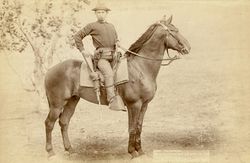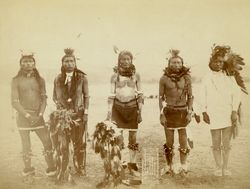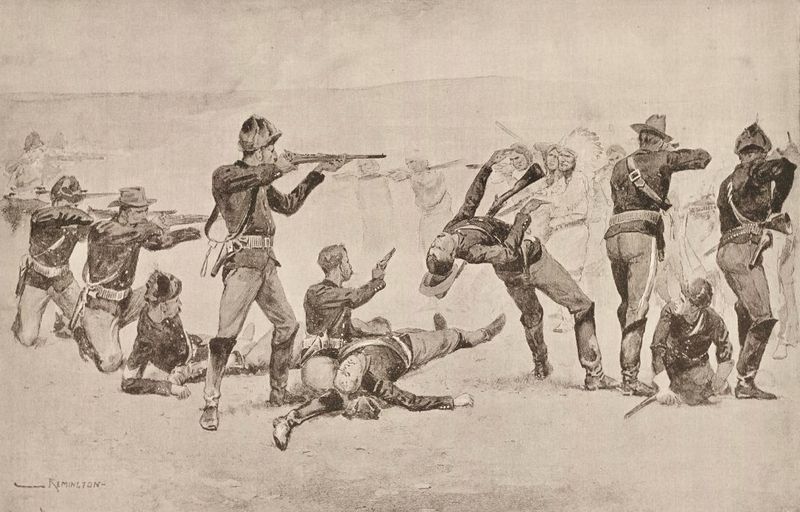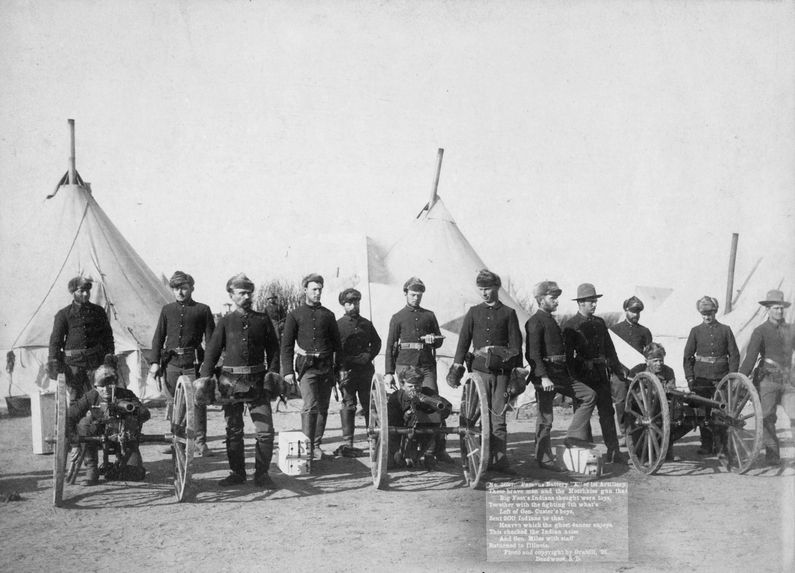Camp Cheyenne
|
HistoryCamp Cheyenne was an Army outpost near the junction of the Cheyenne River and the Belle Fourche River. The post was designed to be a base of operations during the period of the Sioux Ghost Dance War (1890-1891). The camp was established in response to a large gathering of Sioux on the western edge of the Cheyenne River reserve, near the forks of Cheyenne River. The Sioux erected cabins and tepees and settled for the summer of 1890 and by the fall their chief Big Foot and his warriors were performing the ghost dance which settlers and soldiers feared was a prelude to war.   The camp was Garrisoned by five companies of troops, three cavalry and two infantry, and a detachment of Indian scouts. Also attached was Company E, 1st U.S. Artillery armed with four Hotchkiss M1875 mountain guns.
Wounded Knee MassacreUnits from Camp Cheyenne were directly involved in the Wounded Knee Massacre on 29 Dec 1890. Chief Bigfoot and his band had left the Cheyenne River Reservation on 23 Dec 1890 for the Pine Ridge Indian Reservation to seek shelter with Chief Red Cloud. On 28 Dec 1890, they were met by a 7th U.S.Cavalry detachment under Major Samuel M. Whitside who escorted the Sioux to Wounded Knee Creek where they made camp. That evening Colonel James W. Forsyth with the rest of the 7th Cavalry from Camp Cheyenne arrived increasing the force at Wounded Knee to 500 soldiers. It was decided to disarm the Sioux in their camp the next day.  The massacre began the next day during the disarming of Sioux by soldiers surrounding the camp. A deaf Sioux warrior, not understanding that he was to turn in his rifle, resisted and the rifle discharged. In reaction to the discharge, both sides began firing at close range and the officers lost control of the men. The artillery then opened up with the Hotchkiss mountain guns on the tepees filled with women and children and the survivors tried to flee the scene. Mounted troops pursued those trying to escape and cut them down, there were few survivors. One of the Hotchkiss guns was brought to bear on a group who had fled into a nearby ravine driving them out into the open after a desperate fight. At least 150 Lakota Sioux were killed and 50 were wounded. Soldiers loaded the survivors onto wagons and took them to the Pine Ridge Reservation. U.S. Army casualties numbered 25 dead and 39 wounded. General Nelson A. Miles later visited the massacre scene and reflected that it was as if the soldiers had gone berserk. A civilian burial party was employed to bury the dead Lakota Sioux in a mass grave. A sixty-foot long by six-foot deep mass grave was filled with the bodies of more than 140 massacred Lakota Sioux. Camp Cheyenne was abandoned early in 1891 after a semblance of peace was restored on the Sioux reservations. Current StatusThe location of Camp Cheyenne is approximate and the GPS coordinates reflect the forks of the Cheyenne. The Wounded Knee Battlefield was declared a U.S. National Historic Landmark in 1965 and was listed on the U.S. National Register of Historic Places in 1966. Wounded Knee hill was the location of the Hotchkiss guns during the battle and the site of the mass grave.
See Also: Sources:
Links:
Visited: No
| |||||||
